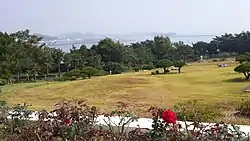Sorokdo
소록도 小鹿島 | |
|---|---|
| Korean transcription(s) | |
| • Hangul | 소록도 |
| • Hanja | 小鹿島 |
 | |
| Country | South Korea |
| Region | Jeolla |
| Area | |
| • Total | 4.46 km2 (1.72 sq mi) |
| Population (2020) | |
| • Total | 708 |
Sorokdo (Korean: 소록도, lit. 'Sorok Island') is an island in Goheung County, South Jeolla in South Korea. The word sorok means "small deer", which the island's coastline, viewed from above, is supposed to resemble.[1] The island is approximately one kilometer away from the larger Nokdong Port.
History
Prior to Japanese colonization, Sorokdo had a population of roughly 1000 people living in 170 households.[2]
Sorokdo is the site of the largest leper colony in South Korea, housed in Sorokdo National Hospital. The hospital was built in 1916, then known as Sorokdo Charity Clinic.[3] Established during the Japanese colonization of Korea, the hospital and the island were turned into a concentration camp for lepers, with a history of patient abuse including slave labor, forced sterilizations, unethical human experimentation, and deliberate starvation.[4] The Japanese authorities divided the island geographically - the eastern portion was a zone for non-patients, i.e. hospital staff and their families, while the western area was used to isolate patients. The dividing line between the two was referred to as sutanjang, meaning 'place of sadness'.[5] Patients were allowed to see their families once a month, but were forced to remain at a distance as the disease was believed to be airborne.
At its peak in 1940, 6,000 patients with Hansen's disease resided on the island.[6] Following the end of Japanese rule, the South Korean government continued to quarantine people with leprosy on Sorokdo until 1963.[7]
In 1962, two Catholic Austrian nurses, Margreth Pissarek and Marianne Stoeger, arrived at Sorokdo to provide treatment for patients and help establish community facilities, such as childcare centers.[8] They are both buried on the island in the patients' cemetery. In 1984 Pope John Paul II visited the island; this was considered a watershed moment in the consideration of the human rights of the remaining patients and residents.[2]
The Japanese colonial law regarding the quarantine of lepers remained in effect in South Korean until 1991; the South Korean government continued to send lepers to Sorokdo National Hospital and seven leper villages remained on the island as of 2007.
Present day
In 2009, the Sorokdo bridge opened, connecting the island to the mainland and the neighboring island of Geogeum.[3] Prior to the bridge's opening, formerly infected people were required to show permission from a doctor to take the ferry to leave the island. The Sorokdodo National Hospital predominantly treats patients with dementia, and the island sees roughly 300,000 tourists per year.
Sorokdo National Hospital Hansen’s Disease Museum was designated as a national specialized museum by the Ministry of Culture, Sports, and Tourism in 2019.
In 1935, Japanese authorities forced patients to build a Shinto shrine to mandate Shinto worship as part of the Japanese assimilationist policy naisen ittai (Japanese: 内鮮一体).[9] Still standing on the island, it is one of the last remaining Shinto shrines left in South Korea.[10] Other religious buildings, including Catholic and Protestant churches as well as Buddhist temples, have been built on the island.
In films
Portions of the 2016 film Dongju: The Portrait of a Poet were filmed on Sorokdo.[11]
References
- ↑ "Korean Leper Colony: Sorok Island". koreabridge.net. May 31, 2011.
- 1 2 Jang, Seong-Gon; Lee, Hyun Kyung; Kang, Dong-Jin (January 2020). "Sustainable Conservation of a Difficult Heritage in South Korea: Mapping the Conservation Resources of Sorok-do Island, Hansen's Disease Site". Sustainability. 12 (17): 6834. doi:10.3390/su12176834. ISSN 2071-1050.
- 1 2 "The Sorokdo National Hospital of South Korea: complicated legacy". Hektoen International - an Online Medical Humanities Journal. 30 December 2020. Retrieved 2022-06-05.
- ↑ "Korean ex-leprosy patients return to island colony". The State. 2013-11-24. Retrieved 2013-11-24.
- ↑ "Island with agonizing past moves forward". koreajoongangdaily.joins.com. 15 April 2015. Retrieved 2022-06-05.
- ↑ "Sorok-do: Island of Patients". Gwangju News. 2021-05-05. Retrieved 2022-06-05.
- ↑ "Sorok Island: The last leper colony". The Independent. 2007-08-19. Retrieved 2022-06-05.
- ↑ "Legacy of sadness and survival on Sorokdo". koreatimes. 2019-08-30. Retrieved 2022-06-05.
- ↑ Administration, Cultural Heritage. "Former Shinto Shrine of Sorokdo Rehabilitation Center, Goheung - Heritage Search". Cultural Heritage Administration - English Site. Retrieved 2022-06-05.
- ↑ Choung, Eun-hye; Choi, Suh-hee (2020-08-02). "Sorokdo as a combined dark tourism site of leprosy and colonized past". Asia Pacific Journal of Tourism Research. 25 (8): 814–828. doi:10.1080/10941665.2020.1767666. ISSN 1094-1665. S2CID 219914985.
- ↑ "Jeollabuk-do Province: Rising Location for Diverse Films". Korean Film. Retrieved 2022-06-05.